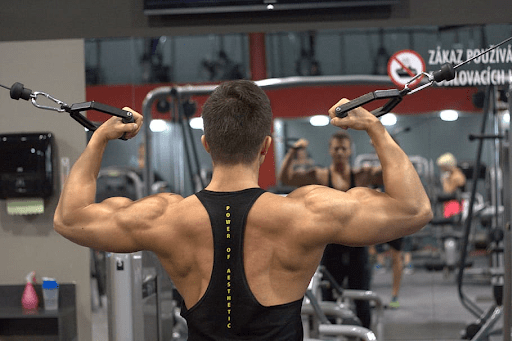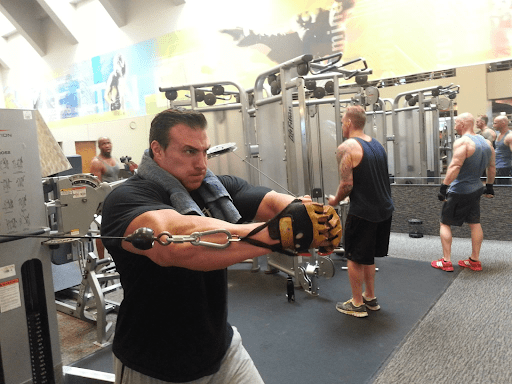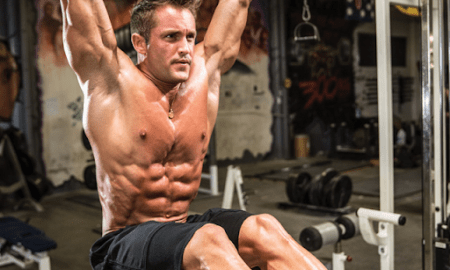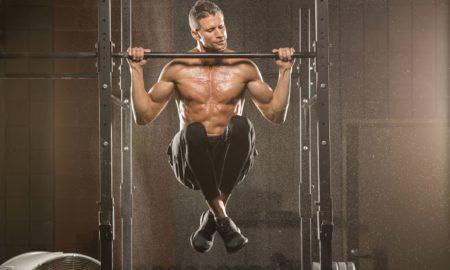

In bodybuilding, training splits are the backbone of a successful workout routine. They allow you to incorporate compound and isolation exercises targeting larger and smaller muscle groups differently. As a result, you gain strength and muscles and create a more balanced and aesthetic physique.
However, with so many conflicting opinions and one-size-fits-all plans, it’s easy to get lost in the sea of information. That’s why we’ve created this comprehensive article to empower you with the knowledge on the perfect training split that aligns with your body and fitness goal.
What is Bodybuilding Split?
Bodybuilding split, also known as a split routine, is a training routine that involves dividing the muscle groups into different training sessions, typically spread across the week. Bodybuilders and advanced weightlifters commonly use this workout program to achieve their fitness goals.
There are several benefits to implementing a split routine into your workout routine, including grouping and working out specific muscle groups differently while allowing ample recovery time. It also reduces the risk of injury associated with working the same muscles consecutively.
A split routine involves switching between different exercises and muscle groups which provides a variety of stimuli to the body. This can help you break through plateaus and prevent training adaptation, leading to continuous progress in muscle development.
5 Factors to Consider When Choosing a Bodybuilding Split
There are various types of bodybuilding splits, but not all of them might support your fitness goal. The factors include the following:
1. Your Training Experience
Your training experience plays a significant role in selecting the proper split routine. As a beginner, you are better off starting with full-body workouts or simpler splits that require less intensity and low volume to build a foundation.
Intermediate and advanced lifters can handle more volume and higher training frequencies. They may benefit from more specialized splits to challenge their muscles and promote growth.
2. Training Goals
Before selecting any split routine, define your specific fitness objectives. Are you aiming for muscle hypertrophy, strength gains, fat loss, or overall fitness? Different splits emphasize various aspects, so choose one that aligns with your primary goal.
If your primary goal is strength, you might prefer a split allowing heavy lifting on crucial compound exercises. For muscle growth, a split that targets each muscle group with higher volume might be more suitable.
3. Time Availability
Consider how many days a week you can realistically commit to training. Some bodybuilding splits require more time in the gym, while others can be completed in fewer sessions.
If you have a demanding job, family responsibilities, or other activities, you may not have adequate time to dedicate to working out; therefore, selecting an upper/lower split, a whole-body split, or a push/pull/leg split will be more beneficial for making progress and better outcome.
4. Recovery Ability
As mentioned, recovery ability is crucial. Some individuals may require more time between training sessions for specific muscle groups to recover fully, while others may recover quickly.
If you are training specific muscle groups that need more time to recover after intense workouts, select a split with more recovery days between the training sessions. A long recovery period allows your body to recuperate and prevent burnout.
If you find yourself constantly fatigued or experiencing persistent muscle soreness, it might be a sign that your current split is not allowing enough time for recovery.
5. Weaknesses and Imbalances
Consider body weaknesses or lagging muscle groups you want to prioritize or improve when selecting a split.
If a particular muscle group needs more attention, choose a bodybuilding split with more training volume and frequency for that area. For instance, specialization training splits are suitable for developing a lagging body quickly.
Moreover, ensure you prioritize training that lagging area before any other muscles after your rest day when you are fully energetic. Focusing on weak areas can help create a more balanced physique and reduce injury risks.

5 Effective Training Splits for Bodybuilders
There are various types of bodybuilding splits, and some common types include the following:
1. Full Body Split
The total body training split is a workout routine that involves training your entire body in a single training session. You perform exercises that works multiple muscle groups simultaneously, typically three times a week, with rest days in between. This increased frequency allows you to stimulate muscle growth more frequently.
Full body split is a popular and suitable choice for bodybuilders with busy schedules and beginners as it is time efficient. You can perform one comprehensive workout daily instead of spending as many days in the gym as other split routines.
The workout split also promotes balanced muscle development by training all muscle groups in a single session. Below is an example of a total body workout that you can perform. Perform each exercise for 3-4 sets of 6-12 repetitions, depending on your goals and fitness level.
- Squats: Targets quads, hamstrings, glutes, and core.
- Bent-Over Rows: Targets back and biceps
- Overhead Press: Targets shoulders, triceps, and upper back.
- Deadlifts: Targets hamstrings, glutes, lower back, and core.
- Bench Press: Targets chest, shoulders, and triceps.
Pros and Cons of Full Body Split
The table below shows the pros and cons of a full-body split:
| Pros | Cons |
|---|---|
| It takes a short time, making it suitable for those with limited time | Muscles have less time to recover between sessions which might lead to overtraining and plateaus. |
| Promotes balanced muscle development and symmetry throughout the body. | Training the entire body in one session can lead to muscle fatigue. |
| You can adapt it for different fitness levels | A limited number of exercises you can perform for each muscle group |
| It has moderate training volume with high-frequency stimulation of muscles. | Limit the isolation of specific muscles for those with targeted goals. |
| Higher caloric expenditure during and after the workout due to its intensity. |
2. Upper-Lower Split
The upper/lower body split is a training split routine that divides the major muscle groups into two categories: upper body muscles (shoulders, chest, back, arms) and lower body muscles ((hamstrings, quads, calves, glutes, abs).
The split allows you to train the upper and lower body muscle groups on separate days with two exercises targeting each group four times a week. This makes it a versatile and effective routine suitable for individuals looking to build muscle and strength or improve overall fitness.
The most common and likely efficient technique to design an upper/lower split for novices to intermediates is to exercise four days a week, training all muscle groups twice. Here’s a common 4-day upper/lower body split:
Day 1: Upper Body Muscles
- Bench Press (chest)
- Bent-Over Rows (back)
- Shoulder Press (shoulders)
- Bicep Curls (biceps)
- Triceps Dips (triceps)
Day 2: Lower Body Muscles
- Squats (quadriceps and glutes
- Deadlifts (hamstrings and lower back)
- Leg Press (quadriceps and glutes)
- Leg Curls (hamstrings)
- Romanian Deadlifts (hamstrings and glutes)
Day 3: Rest or Active Recovery
Day 4: Repeat upper body training, performing two workouts per muscle group.
Day 5: Repeat lower body muscle training, performing two workouts per muscle group.
Day 6-7: Take two complete rest days to allow your body to recover before starting the next training week.
Pros and Cons of Upper/Lower Body Split
The table below shows the pros and cons of upper/lower body split:
| Pros | Cons |
|---|---|
| Suitable for intermediate lifters | Not suitable for beginners |
| Balanced body development | Intensity constraints |
| Creates room for more exercise variation | Limited volume per muscle group |
| Efficient as it targets multiple muscle groups in a session | Unbalanced training time since upper-body training takes longer than lower-body training |
| It allows sufficient time for recovery between sessions. | Lower body training is more intense. |
| Offer a moderate training frequency and moderate-high volume for hypertrophy. | Offer shorter recovery time between sessions which may hinder recovery. |
3. Push/Pull/Leg Split
Push/pull/ leg split divides your major muscles into three categories – pushing muscles (chest, shoulders, and triceps), pulling muscles (the back and biceps) and legs.
On day one, you focus on muscles involved in pushing movements, primarily the chest, shoulders, and triceps. On day two, you emphasize muscles involved in pulling moves, such as the back and biceps. Last, on day three, you work out the lower body muscles, including the quadriceps, hamstrings, glutes, and calves.
You can structure push/pull/leg split in various ways, depending on how many days you plan to work out each week. You can do it once a week, Monday, Wednesday, and Friday, or twice a week, training three days straight, then taking a day off before beginning again, working out six days in a row with day seven off.
Here are the two standard configurations. Aim for 3-4 sets of each exercise, with around 6-12 repetitions per set. The number of sets and reps can be adjusted based on your fitness and experience level.
Day 1: Push (Chest, Shoulders and Triceps)
- Bench Press, Push-ups, and Cable crossover for chest muscles
- Lateral raise, Shoulder Press, and Arnold press for shoulder muscles
- Triceps dips, skull crusher, and bench dips for triceps muscles
Day 2: Pull (Back and Biceps)
- Pull-ups, Reverse fly, and rows exercises for back muscles
- Bicep Curls, hammer curls, and cable curls for biceps
- Face Pulls for rear delts and upper back
Day 3: Legs
- Squats (quadriceps and glutes)
- Deadlifts for hamstrings and lower back
- Leg Press and Lunges for quadriceps and glutes
- Leg Curls for hamstrings
- Calf Raises for calves
Day 4: Repeat the above training to day six and rest on day seven or rest and continue the next day for the second round.
Pros and Cons of Push/Pull/Leg Split
The table below shows the pros and cons of Push/Pull/Leg Split:
| Pros | Cons |
|---|---|
| Suitable to intermediate to advanced bodybuilders | Over time, your body may adapt to the training stimulus, leading to plateaus in muscle growth |
| It allows for more flexible planning and more economical | The Push/Pull split may not be ideal for beginners |
| Provide variety in your workouts, keeping your training interesting and preventing boredom |
4. The Four-Day Training Split
The Four-Day Training Split is a famous workout routine that divides the major muscle groups into four separate workout days. This split type allows for more focused training on each muscle group. It also provides ample time for recovery between workouts.
The four-day bodybuilding split is often used by intermediate to advanced lifters who have developed a solid foundation of strength and conditioning over the week.
The best way to group muscles here is to pair large muscles with smaller ones that perform the same movements. For instance, pairing chest and triceps muscles involved in pushing or back and biceps.
However, train large muscles first before smaller muscles because smaller muscles are more likely to get fatigued faster, making it difficult to work out large muscles that may need their support.
Alternatively, you can pair opposing muscle groups like the back and triceps, chest and biceps. In this scenario, include a rest day or leg day between those sessions to avoid working the same muscle group on successive days.
The typical structure of the Four-Day Training Split is as follows:
Day 1: Chest and Triceps
- Bench Press (chest)
- Incline Dumbbell Press (chest)
- Dumbbell Flyes (chest)
- tricep Pushdowns (triceps)
- Overhead Tricep Extensions (triceps)
Day 2: Back and Biceps
- Pull-Ups (back)
- Barbell Rows (back)
- Seated Cable Rows (back)
- Bicep Curls (biceps)
- Hammer Curls (biceps)
Day 3: Rest or Active Recovery
Dedicate this day to rest or light activities like walking, yoga, or stretching to promote recovery and prevent overtraining.
Day 4: Shoulders and Legs
- Dumbbell Shoulder Press
- Lateral Raises
- Front Raises
Day 5: Legs
- Squats (quadriceps and glutes)
- Leg Press (quadriceps)
- Leg Curls (hamstrings)
Day 6: You can do additional training targeting weaker muscle groups, specific goals, or rest.
Day 7: This is a rest day to allow your body to fully recover before starting the next training week.
The Cons and Pros of Four-day Bodybuilding Split
The table below shows the cons and pros of a four-day bodybuilding split:
| Pros | Cons |
|---|---|
| It allows for more rest days than other splits, such as the five or six-day splits | It requires rigorous training on specific days leading to fatigue and decreased performance. |
| Allows you to customize the routine to your goals and preferences | Longer workouts since you're targeting multiple muscle groups in each session |
| Target specific muscle groups more intensely, leading to better muscle development and overall strength gains. | It is unsuited for bodybuilders with limited time or those who prefer shorter, more frequent workouts. |
| Improved workout intensity, leading to better performance. | Not ideal for beginners |
The Five-Day Split
The five-day split training is a workout routine designed to focus on different muscle groups each day of the week for five days. It is a famous workout routine that many athletes and fitness enthusiasts use to target other muscle groups to build strength and muscles.
The routine can be adjusted according to your goals, preferences, and experience levels. Here’s a general guide on how to perform the five-day split:
Day 1: Chest
- Incline Dumbbell Press
- Chest Flyes
- Push-ups
Day 2: Back
- DeadliftsPull-ups
- Lat Pulldowns
- Bent-over Rows
- Seated Cable Rows
Day 3: Shoulder
- Overhead Press (Barbell or Dumbbell)
- Lateral Raises
- Face Pulls
Day 4: Arms
- Biceps Curls
- Hammer Curls
- Triceps Dips
- Triceps Pushdowns
Day 5: Leg
- Squats
- Romanian Deadlifts
- Leg Press
The Cons and Pros of Five-day Bodybuilding Split
The table below shows the cons and pros of a five-day bodybuilding split:
| Pros | Cons |
|---|---|
| It allows for a targeted focus on specific muscle groups daily | It demands a significant time commitment of five days a week |
| The five-day split allows versatility and customization, accommodating different fitness goals and preferences | Not suitable for beginners or intermediate bodybuilders with limited experience |
| You can tailor exercises, repetitions, and weights to suit your needs | Not efficient for bodybuilders seeking overall fitness and cardiovascular improvements, as it primarily emphasizes resistance training. |
Conclusion
Bodybuilding split is a strategic approach to structuring your workout routine. It allows you to concentrate on specific muscle groups, increase training volume, and prevent overtraining, enhancing muscle growth and overall progress in your fitness journey.
Remember that any workout program’s effectiveness depends on consistency, proper nutrition, and adequate rest.
Additionally, before starting any new bodybuilding split training program, it’s advisable to consult with a fitness professional or personal trainer to ensure the routine aligns with your individual needs and capabilities.






















You must be logged in to post a comment Login